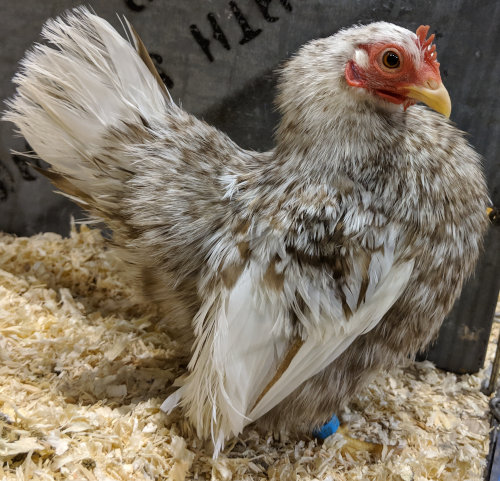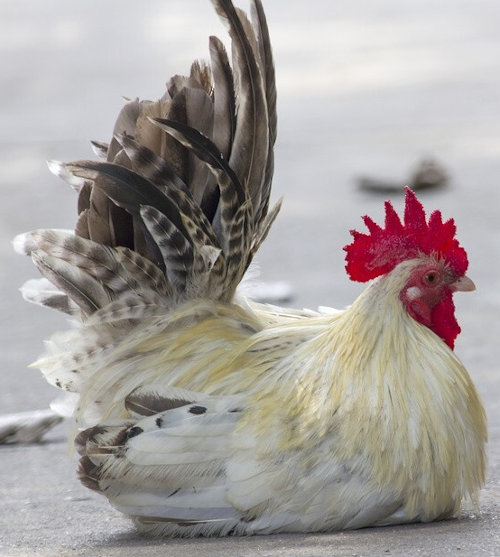Japanese bantam breed standards and characteristics.

Type, or shape is very important, It's what makes Japanese Bantams.
Japanese bantam colours:
There are many colour varieties of Japanese bantam, with standardised colours including:
- Birchen grey,
- Black,
- Black mottled,
- Black-tailed buff,
- Black-tailed white,
- Blue,
- Blue mottled,
- Blue-red,
- Brown-red,
- Buff Colombian,
- Cuckoo,
- Dark grey,
- Golden duckwing,
- Gray,
- Lavender,
- Miller's gray,
- Partridge,
- Red,
- Red mottled,
- Silver-grey,
- Tri-coloured,
- Wheaten,
- White.
There are also frizzle-feathered and Silkie-feathered variations.
Below: A Silkie feathered Japanese Bantam.

Not all are in every countries standards.
Breeding, characteristics and exhibition of the Japanese bantam:
Japanese bantams are a very old and well standardised breed of chicken. It is well known for it's small size, short legs and big personality. It is sometimes called the Chabo, which means dwarf in Japanese.
In most of the poultry shows I have been to over the years the Japanese bantam has been well represented, both in terms of the quality of the birds on show and in the sheer numbers.
Shape of Japanese bantam male:
COMB: Single-very large in comparison to size of bird, set firmly and evenly on head, straight and upright, evenly serrated with five regular and distinct points, the middle points the longest and the same length as the width of the blade, front not to extend beyond point half way between nostrils and point of beak, but extending well over back of head, with tendency to follow shape of neck.
BEAK: Very strong, stout, well curved.
FACE: Smooth, full over eyes, fine in texture, free from wrinkles or folds.
EYES: large, round, prominent.
WATTLES: large, well rounded at lower edges, free from wrinkles or folds.
EAR LOBES: large, elongated oval, smooth, free from wrinkles or folds.
HEAD: Broad, large in comparison to size of bird.
NECK: Fairly short, full, tapering from shoulders to head, on the order of what is termed "bull-necked."
HACKLE: Abundant, falling gracefully and plentifully over: shoulders and well down back, nearly meeting in front of neck.
BACK: Very short, broad, in profile, shaped like a very narrow U with neck and tail forming the vertical sides.
SADDLE: Abundant, filling the space between stern and wing ends, extending from middle of back to tail coverts.
TAIL: Very large and upright, carried in so erect a position as to almost contact the back of the head, slightly forward of perpendicular. Main Tail- feathers wide, well spread in a neatly overlapping manner, rising above the head by one half of their length.
Below: A Japanese bantam male showing the high tail.

Sickles-very erect, long, broad sword-shaped, only slightly curved in a convex manner. Lesser sickles-fairly upright, convexly curved, sword-shaped. Coverts-abundant, conventionally curved, broadly sword-shaped.
WINGS: large, long, closely folded, carried rather low and well back from front of breast, tips trailing well in rear of stern, lower edges not quite touching the ground. Shoulders & Fronts-prominent, partially concealed by hackle. Bows-well rounded. Coverts-feathers broad, forming two distinct bars across wings. Primaries-moderate width, rather long, completely hidden by secondaries. Secondaries-broad, tapering convexly to a point beyond stern.
BREAST: Well-developed, broad, full, carried prominently forward beyond a vertical line drawn down from tip of beak, well rounded.
BODY & STERN: Body-short, very deep, compact. Stern-fluff, short abundant.
LEGS & TOES: Legs-shortest legs of any breed of bantams except Creepers; widely set, thick, parallel to each other without bowing or knock knees, hardly visible. Lower Thighs-short, stout at top and tapering abruptly to hocks. Shanks-extremely short, smooth, round, evenly scaled. Spurs-short, hard, fine. Toes-four, straight, well and evenly spread, evenly scaled.
APPEARANCE: Small, low built, broad and cobby, full feathered upright tail.
Shape of Japanese bantam female:
COMB: Single-large in comparison to size of bird, set firmly and evenly on head, straight and upright, evenly serrated with five regular and distinct points, the middle point the same in length as the width of the blade, moderately arched.
BEAK: Strong, stout, well curved.
FACE: Smooth, full over eyes, fine in texture, free from wrinkles or folds.
EYES: Large, round, conspicuous.
WATTLES: Medium size, round, fine in texture, free from wrinkles or folds.
HEAD: Broad, large in comparison to size of bird.
NECK: Fairly short, full, tapering gracefully from shoulders to head.
HACKLE: Abundant, flowing down over back and cape.
BACK: Very short, broad; in profile, shaped like a very narrow U with neck and tail forming the vertical sides.
CUSHION: Short, feathers broad and plentiful.
TAIL: Very large and upright, carried in an upright position so as to almost contact the back of the head, slightly forward of perpendicular. Main Tail-feathers wide, well spread in an neatly overlapping manner, rising above the head by one half of their length. Coverts-abundant, becoming very broad flowing well up tail.
WINGS: large, long, closely folded, carried rather low and well back from front of breast, tips trailing well in rear of stern, lower edges not quite touching the ground. Shoulders & Fronts-prominent, slightly concealed by hackle.
Below: A black Japanese bantam hen.

Bows-well rounded. Coverts-feathers broad, forming two distinct bars across wings. Primaries-moderate width, rather long, completely concealed by secondaries. Secondaries-broad, tapering convexly to a point welt beyond stern.
BREAST: Well developed, full, carried prominently forward beyond a vertical line drawn down from point of beak, broad and well rounded.
BODY & STERN: Body-short, very deep, compact. Stern-fluff, short, abundant.
LEGS & TOES: Legs-shortest legs of any breed of bantams, except Creepers, widely set, parallel to each other without bowing or knock knees, hardly visible. Lower thighs-short, stout at top and tapering to hocks. Shanks-extremely short, smooth, round, evenly scaled. Toes-four, straight, well and evenly spread, evenly scaled.
APPEARANCE: Small, broad, compact, with large upright tail.
Defects in the Japanese bantam.
- Comb with thumb mark.
- Irregularly serrated or lopped comb.
- Small and/ or narrow head
- Unduly long, straight or slim neck.
- Long and/or narrow back.
- Narrow or shallow breast.
- Male sickle feathers curved in a concave manner towards the head.
- Any semblance of stiltiness.
When judging the Japanese bantam, the back is worth 12 points and the breast is worth 10 points. This is out of a total of 100 points. The breast and the back of the Japanese can make or break the bird.
If the breast is held high or too narrow the bird should be culled. If the back is anything but a nice narrow U, it should go into the stew pot.
You can cull too early, Japanese females don't type up as fast as males do. Patience is your ally.
